Beyond mere myth, Astaroth's biblical presence unveils a complex interplay of ancient beliefs and modern interpretations, inviting deeper exploration.
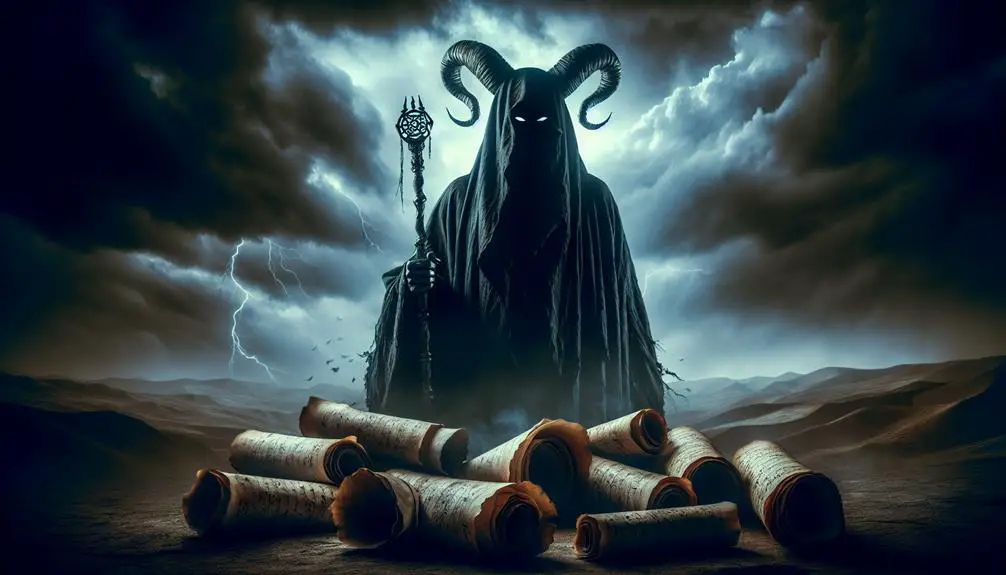
Astaroth in the Bible
Amid ancient anecdotes and artifacts, Astaroth appears as a perplexing presence in biblical passages. You've likely encountered mentions of this entity, weaving through the texts as a symbol of Canaanite religion and idolatry, yet its origins and implications extend beyond mere opposition.
As you explore the historical contexts and cultural interpretations, you'll uncover layers of meaning that challenge conventional understandings. This journey into the past not only illuminates Astaroth's role in biblical narratives but also invites a broader reflection on how ancient beliefs continue to shape modern perspectives.
Why does Astaroth's story matter today? Let's find out together.
Key Takeaways
- Astaroth symbolizes idolatry and the temptation to stray from monotheism in the Bible.
- Biblical narratives contrast Canaanite worship of Astaroth with the worship of Yahweh.
- The worship of Astaroth is depicted as having negative consequences on ancient societies.
- Astaroth's transition from deity to demon highlights the shift in religious beliefs due to monotheistic influences.
Origins of Astaroth
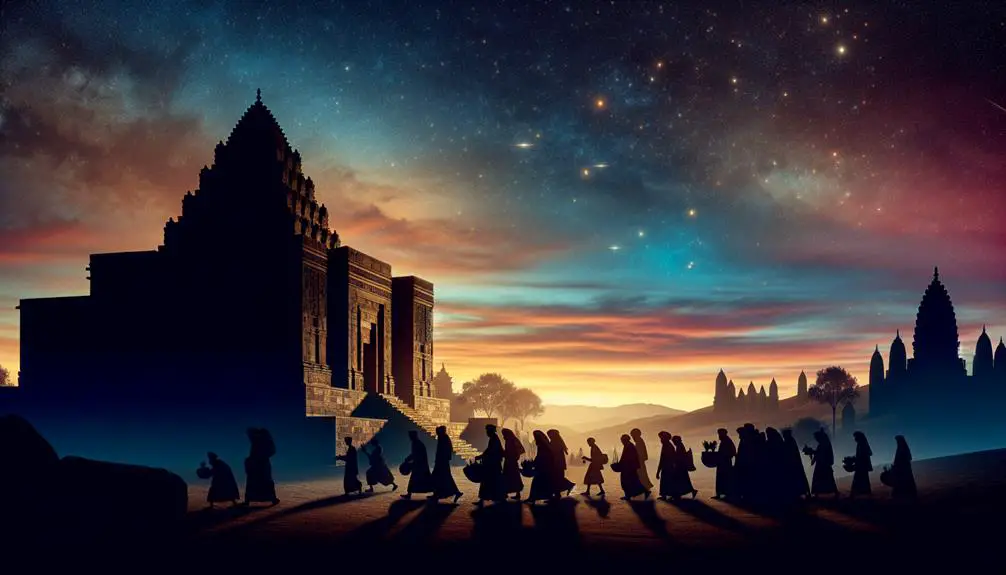
Astaroth's origins trace back to ancient Near Eastern religions, where this entity was revered as a fertility goddess and a figure of worship among various cultures. The etymology of Astaroth itself is fascinating, stemming from the ancient Semitic root 'Ashtoreth', which was the name of a Canaanite goddess. This linguistic lineage highlights the deity's profound connection to fertility, love, and war, themes prevalent in the worship practices of these early societies. Over time, as cultures evolved and interacted, Astaroth's identity and attributes underwent significant transformations, reflecting the complex interplay of religious syncretism.
In terms of demonology connections, Astaroth's transition from a deity to a demon is a testament to the multifaceted nature of religious evolution. This metamorphosis can be traced to the influence of monotheistic religions, which often recast the pantheons of preceding polytheistic cultures into demonic hierarchies. Thus, Astaroth's current association in demonology as a Grand Duke of Hell, commanding legions of spirits, is a stark departure from its origins. This demonological depiction underscores the entity's knowledge of the past, seductive skills, and the ability to lead humans to laziness and vanity, reflecting a complete inversion of its ancient characteristics of fertility and protection.
Analyzing Astaroth's etymology and demonology connections reveals the intricate journey from a revered deity to a demonized figure. This transformation underscores the dynamic nature of religious and cultural narratives, shaped by the shifting sands of history, power, and belief systems.
Biblical Mentions and Contexts
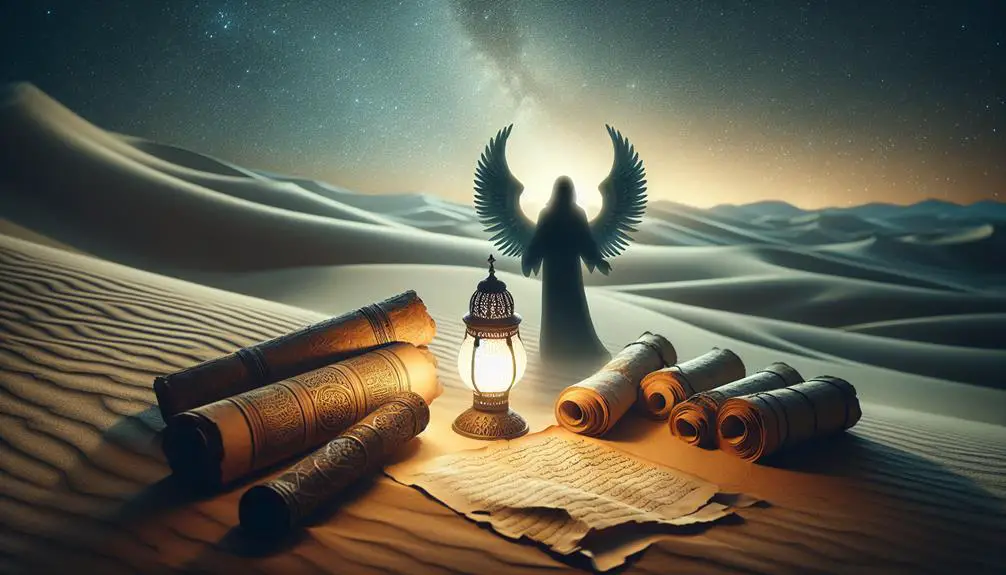
Exploring the biblical texts reveals that Astaroth, known in the context of ancient Near Eastern religions as a fertility goddess, assumes a markedly different identity within the scriptural narratives. The transformation of Astaroth's character from a deity revered in surrounding cultures to a figure symbolizing idolatry and opposition to the monotheistic worship of Yahweh offers a fascinating subject for comparative analysis, emphasizing the divergent religious perspectives between the Israelites and their neighbors. This shift underscores the complexity of historical accuracy in the biblical accounts, where theological agendas often shape the portrayal of foreign deities.
To understand the nuances of Astaroth's depiction in the Bible, consider the following points:
- Contrast with Canaanite Worship: The Bible positions Astaroth in stark opposition to Yahweh, reflecting the broader conflict between Israelite monotheism and Canaanite polytheism.
- Symbol of Idolatry: Astaroth frequently symbolizes the temptation of Israel to stray from the worship of Yahweh, serving as a litmus test for fidelity to the covenant.
- Historical Contextualization: The biblical narratives embed Astaroth within specific historical and cultural contexts, offering insights into the geopolitical and religious dynamics of the time.
- Theological Implications: The treatment of Astaroth in the Bible serves as a vehicle for theological teachings about idolatry, morality, and the consequences of abandoning Yahweh.
This analysis highlights the importance of considering the biblical text not just as a historical document but as a complex interplay of theology, culture, and historical narratives. Understanding Astaroth's biblical mentions requires a nuanced approach that respects the text's multifaceted nature.
Astaroth and Canaanite Religion
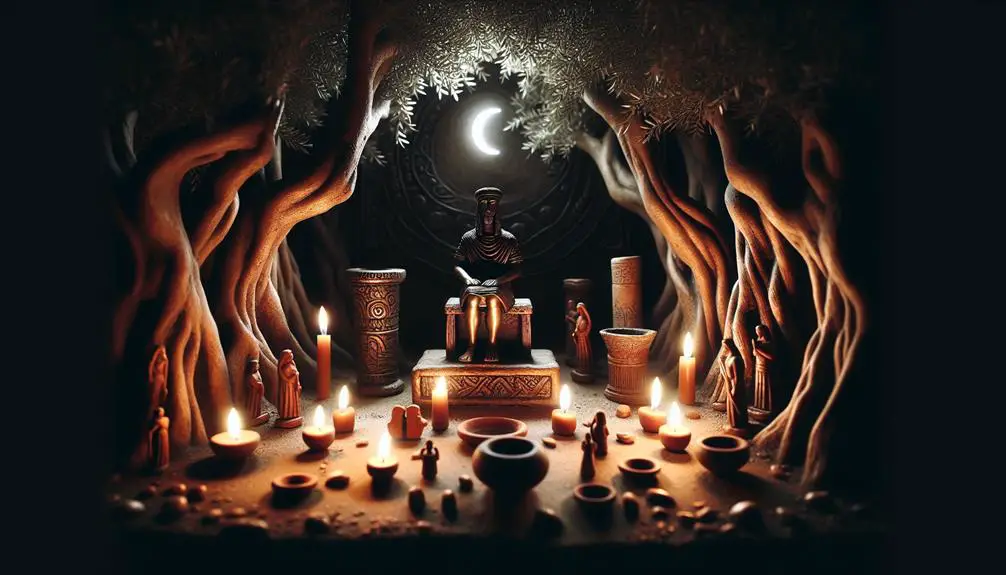
As you explore Astaroth's role in Canaanite religion, it's crucial to examine the deity's divine attributes, which illuminate the cultural and religious landscape of the ancient Near East.
The worship practices associated with Astaroth provide insight into the spiritual life and societal norms of Canaanite communities.
Furthermore, biblical condemnations of Astaroth worship reflect the complex interplay between Canaanite religions and the emerging Israelite identity.
Astaroth's Divine Attributes
Several divine attributes define Astaroth within the context of Canaanite religion, underscoring his complex role as a deity. As you delve deeper into the nuances of Astaroth's character, you'll notice that his attributes reveal much about the Canaanite understanding of the divine and the celestial hierarchy. Importantly, Astaroth's representation brings to light aspects of divine femininity, challenging and enriching our understanding of ancient deities.
- Embodiment of fertility and war, showcasing the duality of creation and destruction.
- Association with divine wisdom, offering insight and guidance.
- Connection to the celestial hierarchy, emphasizing his position among gods and goddesses.
- Symbol of divine femininity, challenging traditional views on divinity and power.
These characteristics not only highlight his significance in Canaanite religion but also offer a window into the society's worldview and theological constructs.
Worship Practices
In the context of Canaanite religion, the worship practices of Astaroth reveal a multifaceted approach to divine veneration, intertwining rituals, offerings, and sacred spaces. You'll find that these practices were deeply rooted in the community's daily and seasonal rhythms, with festival rituals and sacrificial offerings playing a pivotal role.
Aspect |
Significance |
|---|---|
Festival Rituals |
Marked seasonal and agricultural cycles, reinforcing social bonds and divine favor. |
Sacrificial Offerings |
Served as a means of communication with the divine, believed to ensure prosperity and protection. |
Sacred Spaces |
Functioned as physical and symbolic centers of worship, where rituals and offerings were performed. |
These elements collectively underscored the community's reliance on and reverence for Astaroth, illustrating a complex relationship between the deity, the natural world, and societal well-being.
Biblical Condemnations
The biblical texts offer a stark condemnation of Astaroth and Canaanite religious practices, framing them as antithetical to the beliefs and commands of the Israelite faith. This perspective reflects not only religious opposition but also underscores the historical accuracy and cultural influence these narratives wield. To better understand this condemnation, consider:
- The texts often depict Canaanite religions as morally and spiritually corrupt.
- They highlight the Israelites' struggle to maintain their faith amidst polytheistic influences.
- The condemnation serves as a warning against idolatry and the assimilation of foreign practices.
- It underscores the importance of fidelity to the covenant between the Israelites and their deity.
These elements collectively emphasize the broader theme of maintaining religious and cultural integrity in the face of external influences.
Idolatry and Opposition
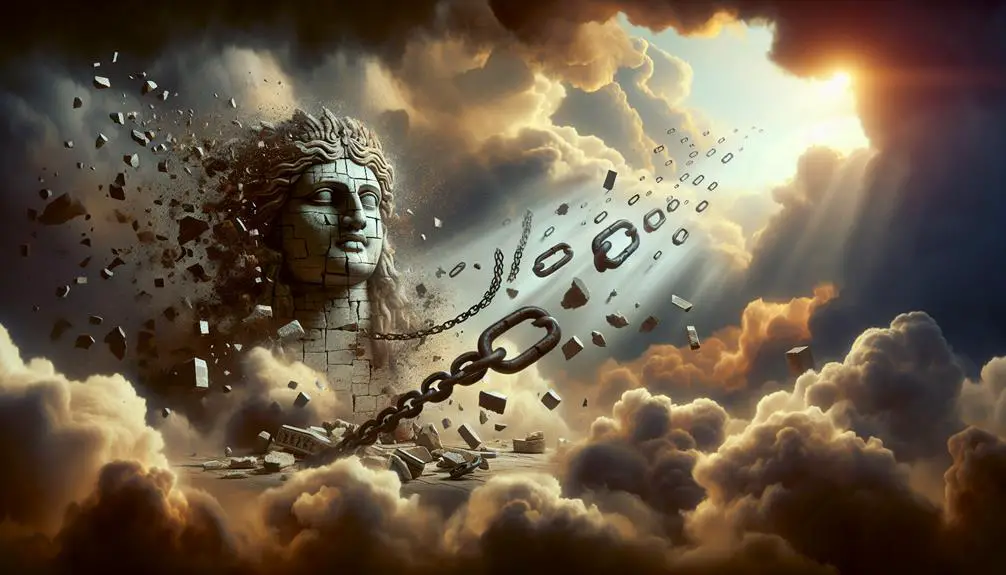
You'll find that Astaroth's depiction in the Bible is intertwined with themes of idolatry and divine opposition.
The scriptures attribute severe consequences to the worship of Astaroth, highlighting a broader condemnation of idolatry within the text.
This narrative serves as a critical lens through which the ancient Israelites' theological and moral stance against idol worship is examined.
Astaroth's Biblical Depiction
Throughout the Bible, Astaroth is depicted as a symbol of idolatry and opposition to the monotheistic worship of Yahweh, challenging believers to reject polytheistic temptations.
- Artistic portrayals: Often, Astaroth's depiction in art and literature has contributed to a skewed understanding of its biblical representation, leading to historical inaccuracies.
- Role in polytheism: Astaroth serves as a testament to the complex interplay between different religious beliefs of the time.
- Contrast with monotheism: This deity's presence starkly opposes the principles of monotheism, underlining the spiritual conflict in ancient texts.
- Influence on culture: The narrative around Astaroth highlights the broader cultural and theological battle between idolatry and the worship of Yahweh.
This analysis underscores the importance of discerning the original biblical context from later interpretations and representations.
Consequences of Worship
Worshiping Astaroth invited severe consequences for ancient societies, reflecting a deep-seated conflict between idolatry and monotheistic principles. This practice not only strained religious beliefs but also significantly influenced social dynamics and economic impact. The devotion to such deities led to a redistribution of resources that could otherwise support societal development.
Aspect |
Idolatry Impact |
Monotheism Response |
|---|---|---|
Economic Impact |
Diversion of resources |
Emphasis on communal wealth |
Social Dynamics |
Stratification based on priesthood |
Focus on egalitarian values |
Religious Harmony |
Fragmentation |
Pursuit of unified belief |
Cultural Identity |
Diversification |
Consolidation around a core |
This table illustrates the stark contrasts idolatry, such as the worship of Astaroth, brought about, urging a reevaluation of priorities within those societies.
Interpretations Across Cultures
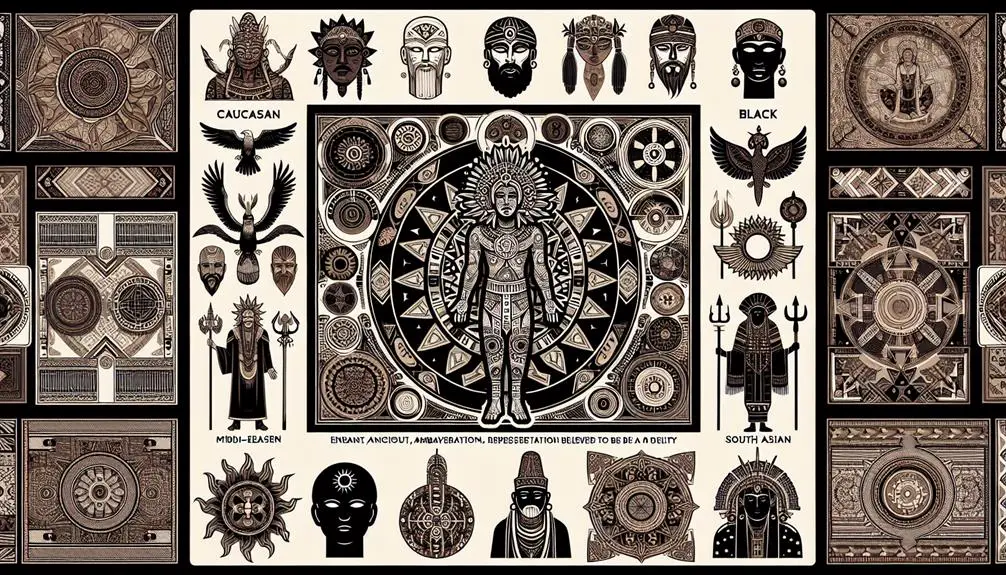
While the figure of Astaroth appears uniformly in biblical texts, interpretations of this entity vary significantly across different cultures. The exploration of Astaroth's etymology and global influences reveals a complex tapestry of religious and cultural perceptions that have evolved over centuries.
- Astaroth's Etymology: The name itself is thought to derive from Astarte, a Phoenician goddess of fertility, love, and war, which suggests an early syncretism between cultures. This connection underscores the fluidity of ancient religious identities and highlights how interpretations of Astaroth have been shaped by a broader, intercultural exchange of ideas.
- Mesopotamian Influence: In ancient Mesopotamia, similar deities were worshipped, indicating that Astaroth's characteristics and roles might've been influenced by earlier, non-Hebrew traditions. This suggests a diffusion of religious concepts across ancient civilizations.
- European Medieval Perception: During the medieval period in Europe, Astaroth was often depicted as a demon within Christian demonology. This transformation reflects the shifting religious landscape and the reinterpretation of older, pagan deities as malevolent figures in Christian theology.
- African and Afro-Caribbean Traditions: In some African and Afro-Caribbean religions, entities resembling Astaroth are sometimes syncretized with saints or other spiritual beings, indicating a complex process of cultural and religious adaptation and resistance.
These variations in interpretation underscore the profound impact of cultural context on religious understanding. They also highlight the dynamic nature of religious figures like Astaroth, whose identities evolve in response to global influences and local traditions.
Modern Perspectives on Astaroth

In recent years, scholars have increasingly focused on understanding how Astaroth's portrayal has shifted within contemporary religious and cultural contexts. This shift is marked by Astaroth's resurgence, not as a mere historical or biblical figure, but as a symbol within the modern occult fascination. You'll find that this resurgence is more than a revival; it's a reinterpretation that reflects broader changes in society's relationship with spirituality, mysticism, and the esoteric.
Historically seen as a demon or a deity in ancient texts, Astaroth's modern depiction often straddles the line between ancient reverence and contemporary occult practice. Scholars argue that this reflects a growing disillusionment with traditional religious structures and a search for more personalized forms of spiritual experience. In this light, Astaroth serves as a case study for the broader phenomenon of spiritual seeking outside mainstream religious institutions.
Moreover, the occult fascination with Astaroth underscores a collective yearning for a deeper understanding of the self and the universe. This fascination isn't merely about rebellion or novelty; it's rooted in a genuine quest for knowledge that transcends the boundaries of orthodox religious teachings. Through this lens, Astaroth becomes a symbol of the human desire to explore the unknown, to question established narratives, and to seek wisdom in places considered forbidden or marginal by mainstream society.
Frequently Asked Questions
How Has the Depiction of Astaroth Evolved in Popular Media and Entertainment, Such as Movies, Books, and Video Games?
In popular media and entertainment, Astaroth's depiction has significantly evolved. You've likely noticed character redesigns that shift away from traditional imagery to incorporate modern or fantasy elements, reflecting Astaroth's symbolism in new, creative ways.
These adaptations span movies, books, and video games, showcasing a broader interpretation of the character. This evolution demonstrates how creators blend historical lore with contemporary aesthetics, ensuring Astaroth remains a relevant and intriguing figure in today's entertainment landscape.
Can Parallels Be Drawn Between Astaroth and Figures From Other Ancient Mythologies Outside of the Canaanite and Biblical Contexts?
You'll find that many ancient mythologies weave similar tales, casting shadows and light on similar figures. Through the lens of scholarly analysis, one can't help but notice the Greek parallels and Mesopotamian influences that echo through these stories.
These connections suggest not just shared themes but deep, intertwining roots of belief and narrative. Analyzing these parallels offers a rich tapestry of cultural exchange and adaptation, far beyond the confines of a single mythological context.
What Specific Rituals or Practices Were Associated With the Worship of Astaroth, According to Archaeological Findings or Historical Records?
You're looking into the specific rituals and practices tied to Astaroth worship, as shown by archaeological discoveries and historical accounts.
Ritual artifacts and sacrificial methods are key indicators. Experts have unearthed items suggesting offerings and ceremonies aimed at appeasement or seeking favor.
These practices often involved complex rites, possibly including animal or symbolic sacrifices. The details, deciphered from ancient texts and relics, paint a vivid picture of the devotion towards this deity.
How Have Feminist Interpretations of Ancient Deities Like Astaroth Contributed to Modern Understandings of Gender Roles in Ancient Religions?
Feminist interpretations of ancient deities have revolutionized modern understandings of gender roles in ancient religions.
Through gender discourse and mythological reinterpretation, you'll find that these perspectives shed light on the fluidity and complexity of gender dynamics that traditional narratives often overlook.
What Role Does Astaroth Play in Contemporary Occult Practices or Neo-Pagan Religions, and How Does This Contrast With Historical Worship?
Today, you'll find Astaroth playing a significant role in contemporary occult practices and neo-pagan religions, often diverging sharply from historical worship. The use of Astaroth sigils in rituals underscores this evolution, as practitioners seek to harness perceived powers or insights.
Additionally, Demonology conferences have become platforms where Astaroth's modern interpretations and relevance are debated and explored, reflecting a scholarly yet objective analysis of this entity's place in contemporary spiritual landscapes.
Conclusion
In scrutinizing the origins and biblical contexts of Astaroth, you've journeyed through ancient texts and cultural interpretations. Astaroth's presence in Canaanite religion and its adoption into biblical narratives showcase a complex interplay of idolatry and opposition.
Across cultures, interpretations vary, reflecting broader theological and sociological dynamics. Modern perspectives further enrich our understanding, challenging us to reconsider Astaroth's role and significance.
This exploration underscores the nuanced nature of ancient deities and their lasting impact on contemporary religious thought.



Sign up